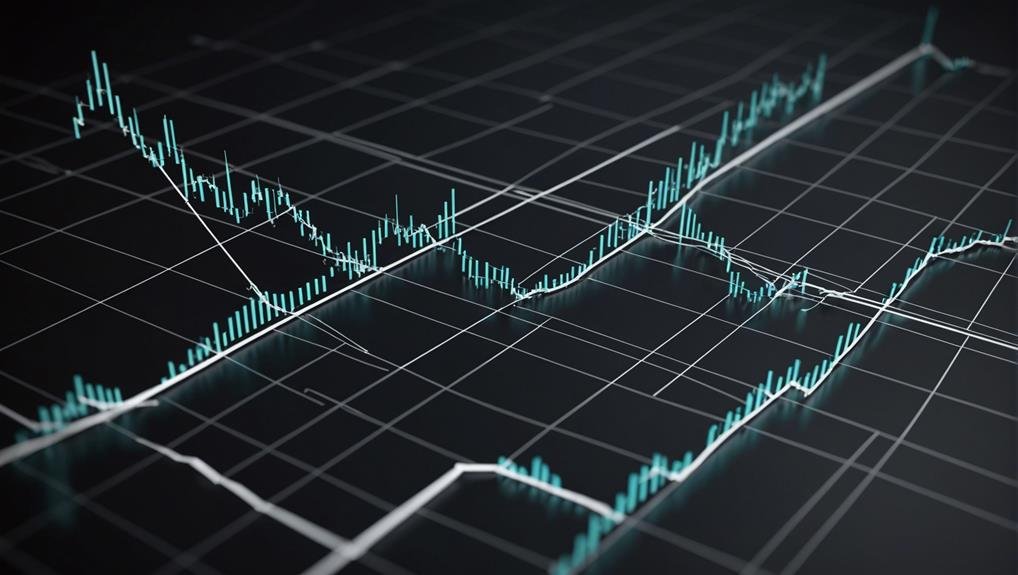Death Cross Definition: How and When It Happens
The Death Cross occurs when the short-term moving average drops below the longer-term moving average, indicating a potential change in market sentiment. It impacts investor psychology and trading choices, aiding in informed portfolio management. Historical data shows mixed outcomes after a Death Cross, with examples like the 11% drop and 19% rally following the December 2018 occurrence. Understanding current market conditions alongside the Death Cross is vital for making investment decisions. Consider further exploration for a detailed analysis of the Death Cross's implications and significance in market trends.
Key Takeaways
- Death Cross occurs when short-term moving average falls below long-term moving average.
- It indicates a potential shift in market sentiment towards a bearish outlook.
- Helps investors understand market trends and make informed decisions on portfolios.
- Considered a bearish signal in technical analysis of financial markets.
- Timing of Death Cross occurrence varies based on market conditions and moving average calculations.
Definition and Characteristics of Death Cross
The Death Cross, a market chart pattern denoting recent price weakness, is characterized by the short-term moving average falling below the longer-term moving average. The timing of the occurrence of a death cross is vital as it often signals a potential shift in market sentiment.
When this event unfolds, it can have a significant impact on investor psychology and trading behavior. Market participants tend to closely monitor the development of a death cross as it may indicate a period of increased volatility and uncertainty.
Understanding the market impact of a death cross can assist investors in making informed decisions regarding their portfolios and risk management strategies.
Historical Significance and Examples
Pivoting from the discussion on the Definition and Characteristics of Death Cross, the historical significance and examples of this market chart pattern provide valuable insights into its impact on market behavior and investor decisions.
The historical outcomes of the death cross have shown mixed results, with the S&P 500 index being higher a year after the occurrence two-thirds of the time. Examples like the December 2018 death cross resulting in an 11% drop followed by a 19% rally, and the March 2020 death cross preceding a 50% gain in the S&P 500 over the next year, highlight the variability in market trends post this pattern.
These instances underscore the importance of considering current market conditions alongside the occurrence of a death cross for informed investment decisions.
Comparison: Golden Cross Vs. Death Cross
Comparing the Golden Cross and Death Cross patterns reveals contrasting market signals based on moving average trends. The Golden Cross, a bullish signal, occurs when the short-term moving average surpasses the long-term moving average, indicating a potential uptrend and buy opportunities.
On the other hand, the Death Cross signifies a bearish outlook with the short-term moving average dropping below the long-term moving average. While the Golden Cross suggests a bullish market trend, historical data shows that the Death Cross has been followed by more significant gains in recent years.
Understanding these patterns is essential for investors to interpret market conditions accurately and make informed decisions based on the prevailing trends and signals provided by moving averages.
Market Limitations and Considerations
Exploring the practical implications of the death cross pattern in financial markets reveals key considerations for investors maneuvering through market volatility.
- The impact analysis of a death cross is dependent on current market trends and historical data.
- Market limitations include the death cross being more of a coincident indicator rather than a leading one.
- Rapid adaptation to market signals by participants may diminish the predictive value of the death cross.
- Understanding the historical context and constraints of the death cross as a market indicator is essential for informed decision-making.
Technical Analysis Concepts: Moving Averages
The analysis of moving averages plays a pivotal role in technical market evaluation by providing a smoothed representation of price trends and assisting in the identification of potential market shifts. Simple Moving Average (SMA) applications involve calculating the average of selected prices, typically closing prices, to reduce price fluctuations in technical analysis.
Crossover strategies, where a security intersects with an indicator on a stock chart, are utilized to generate buy/sell signals and indicate shifts in market momentum. Moving Averages (MA) act as filters for random price noise, aiding in trend identification and offering a visual depiction of price action to confirm market direction in various trading strategies.
These tools are essential in helping traders navigate market movements effectively.
Timing and Occurrence of Death Cross
An analysis of the timing and occurrence of the death cross provides valuable insights into market trends and potential shifts in investor sentiment.
- Market Implications: Understanding when a death cross occurs can help investors gauge the momentum of a market trend and make informed decisions about their portfolio allocations.
- Trading Strategies: Timing the market based on the occurrence of a death cross can be a useful strategy for traders looking to capitalize on short-term price movements and adjust their positions accordingly.
- Historical Trends: Examining past occurrences of the death cross can offer valuable insights into how different assets have reacted following this technical signal.
- Risk Management: Incorporating the timing of a death cross into risk management strategies can help investors protect their portfolios during periods of potential market weakness.
Understanding Market Impact of Death Cross
Understanding the market impact of the death cross involves a thorough analysis of historical data and market reactions to this technical signal. Market psychology plays an essential role in interpreting the significance of the death cross.
Investors' reactions to this bearish indicator can vary, influencing market trends and volatility. Successful investment strategies following a death cross often involve a mix of risk management, portfolio diversification, and a long-term perspective.
Traders may choose to implement defensive measures, such as reducing exposure to equities or increasing investments in assets like bonds or gold, to mitigate potential losses during periods of market uncertainty. By understanding market psychology and applying suitable investment strategies, investors can navigate the implications of a death cross more effectively.
Conclusion
To sum up, it is noteworthy that the death cross serves as a significant market indicator that can indicate potential shifts in market trends.
A study conducted by MarketWatch revealed that over the past 50 years, the S&P 500 index has seen an average return of 24% in the 12 months following a death cross.
This data underscores the significance of comprehending and monitoring the implications of this pattern for well-informed investment decisions.







